Unlimited Field Mapping for OnePager Live Beta 2
Contents
About Unlimited Field Mapping
7.19.1-OPL2
In previous versions of OnePager, if you wanted to use a source field that was not already in your project view, you had to start over. You went back to the Template, mapped the additional field for the purpose you needed, and created a new project view. This was cumbersome and inefficient, especially if you had already invested time editing the original project view before you realized that you needed another field.
1) With version 6.0 we provide a new feature called Unlimited Field Mapping (UFM) that is a vastly more efficient way to bring additional fields into a project view after you've created and edited it.
2) Previously, OnePager would only have access to Microsoft Project or Excel source plan fields that were specifically mentioned in the OnePager Template.
3) Now with UFM, a project view has access to all source plan fields. Field Mapping is defined as the use of a source plan field for a particular OnePager purpose. There are more than 25 OnePager purposes from Baseline Finish Date to Unique task/milestone identifier.
- a) With this enhancement you can now easily refer back to your source plan and access changed fields for your project view.
- b) For example, you can populate a Text field in Microsoft Project and then use that field to present data in an Additional Text Column after the project view was first created.
4) Further, OnePager Pro gives you a more efficient way to change the field mapping for eight (8) of the most frequently used OnePager Pro presentation purposes. For OnePager Express there are seven (7) such purposes because it omits display of critical path information.
5) All this is explained further below.
Using Unlimited Field Mapping – A Microsoft Project Example
1) Suppose we use a source plan called BlueGrass Project 2J-303-RCM Example. If we look at the field headings from this Microsoft Project source plan they would look like this:
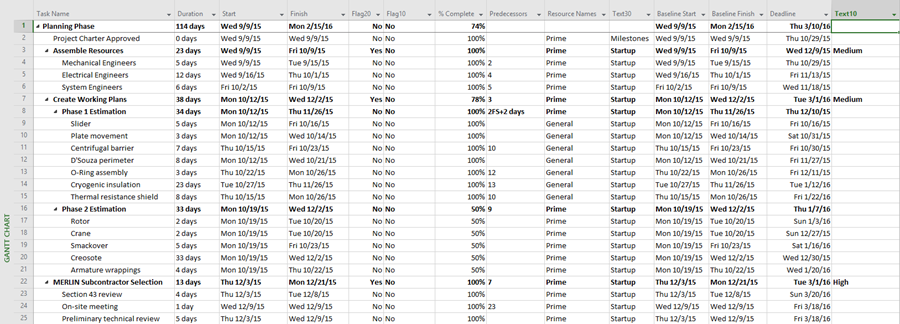
2) Along with the typical Task Name, Duration, Start date and Finish date fields and some others, there are two flag fields (Flag20 and Flag10) and a text field (Text10) which appears to be used to specify the Task's estimated risk. If we create a simple project view using the standard Single Project Gantt View – Detailed Template and Flag20 to control the import, we will get a project view that looks something like this:
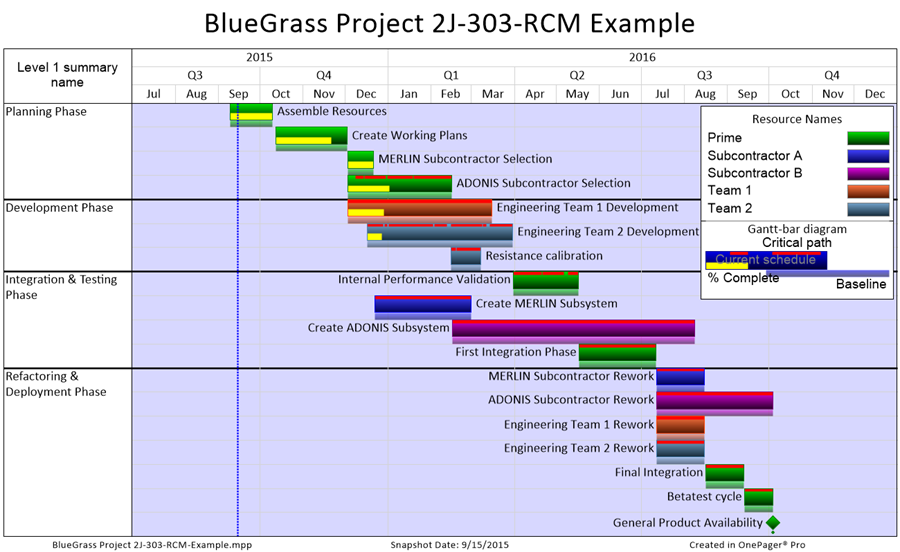
3) To see where the Unlimited Field Mapping first comes into play, let’s look at the Project-View Properties (PVP) form’s Rows/Swimlanes tab and one of the dropdown lists that contain field names from the source plan. An example from the Rows/Swimlanes tab is shown here:
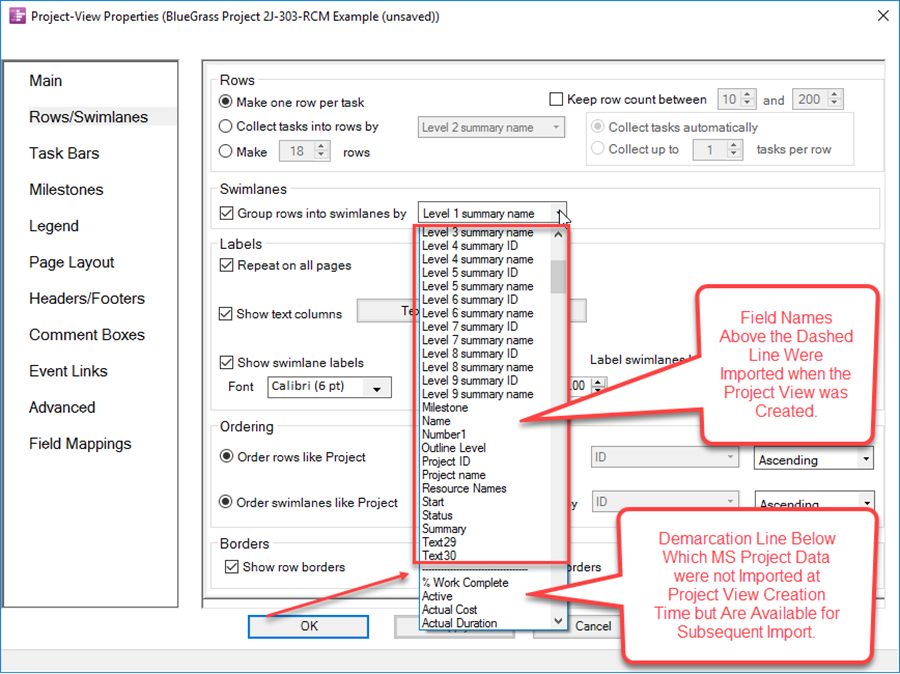
4) In the dropdown list above all the field names from the Microsoft Project source plan that were imported when the project view was created as shown ABOVE the dotted line. The fields listed BELOW the dotted line are actually all available to OnePager now because of Unlimited Field Mapping. In prior releases of OnePager, the hundreds of fields below the dotted line would not be available for you to use after you created the project view!
5) For the sake of this example, let’s suppose that we want to use additional data from our Microsoft Project source plan shown above. Our purpose in this example is to bring in the new data from Microsoft Project (e.g., Text10 field) and use the data to populate an additional text column in the updated project view.
6) To accomplish this project view update, we need to tell OnePager Pro that we want to use the Text10 field for the purpose of creating an Additional Text Column.
- a) This is done by bringing up the PVP form's Rows/Swimlanes tab and clicking the Text Column Properties... button.
- b) This action brings up the Custom Text Columns form where we select the Left#1 tab and check the Show this checkbox.
- c) Next, go to the dropdown window to the right of the Show this checkbox and display the dropdown list of available fields.
- d) Go down the dropdown list, blow the Dashed Line, until you find the Text10 entry and select it:
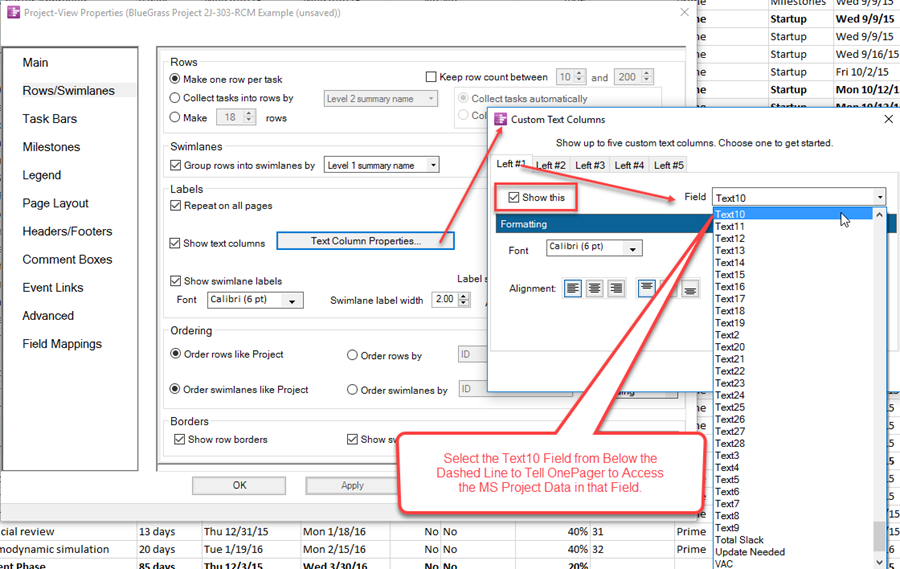
7) When you are finished establishing the controls for the Additional Text Column, click OK on the Custom Text Columns form and OK on the PVP form. OnePager Pro will now go out to your Microsoft Project source plan, import the data in the Text10 field, and re-configure the project view to look like this:
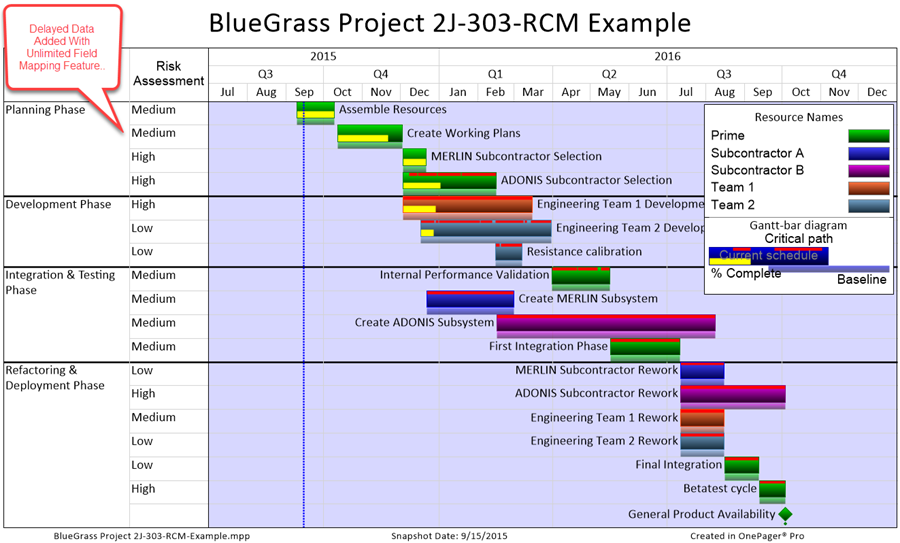
8) You can edit the Additional Text Column header by changing it from Text10 to Risk Assessment, perhaps.
9) The same methods apply when your source plan is Microsoft Excel and you are using OnePager Express.
Simplification Change Made to the Template form’s Other Columns Tab
1) Recall that previous versions of OnePager Pro and Express used the Other Columns tab in the Template form for several purposes. Among these purposes was the selection of source plan fields that may be used later on with the project view, selection of fields for some presentation purposes, and to identification of an optional field for field splitting.
2) What we’ve done in the Template form is renamed the Other Columns tab to the Field Mappings tab, simplified the remapping in this new tab to eight (8) OnePager Pro column purposes (seven (7) for OnePager Express), and retained the field splitting controls. In addition, we've add Task/Milestone Identity controls to assist with Unique ID issues discussed elsewhere in this Wiki.
MS Project Source
- a) The new Field Mappings tab in the Template form for OnePager Pro looks like this:
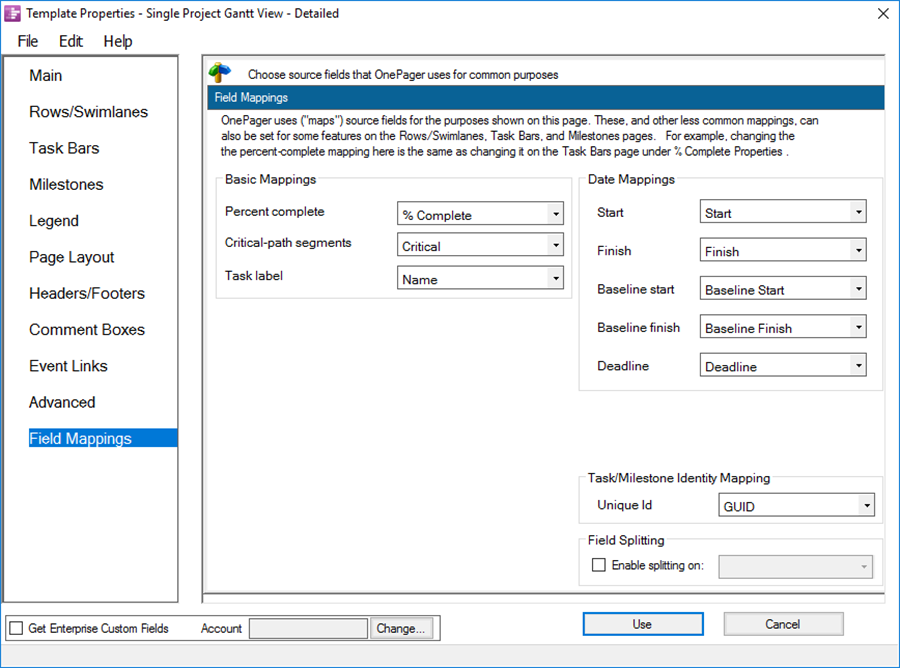
- i) The eight dropdown lists shown in the upper part of the form above are common uses that our customers need most frequently, but there are other important purposes on the Rows/Swimlanes tab and the Task Bars and Milestones tab of the PVP form.
- ii) Each dropdown list contains the Microsoft Project source plan fields of data types appropriate for its purpose. For example, the Critical-path purpose allows only Boolean and Numeric fields, whereas the dropdowns in the Date Fields group contain only date fields and the Percent-Complete purpose allows only numeric fields.
- b) The Field Splitting group in the Field Mappings tab of the OnePager Pro Template form works in the same way as it did in the Other Columns tab. See the article at: Splitting and Parsing Fields-MS Project Source 24.4.1-OPL2 for more information.
- c) The Unique Id control in the Task/Milestone Identity Mapping group shows the Microsoft Project source plan field that OnePager Pro used when it first created the project view.
- i) This feature is added to assist advanced OnePager Pro users for updating project views when they have copied one Microsoft Project source plan into another.
- ii) The Task/Milestones Identity Mapping group is also found on the Project-View Properties form's Field Mappings tab, but it is disabled there because you cannot change the Unique Id after a project view is created.
MS Excel Source
- e) The Field Mappings tab in the Template form for OnePager Express looks like this:
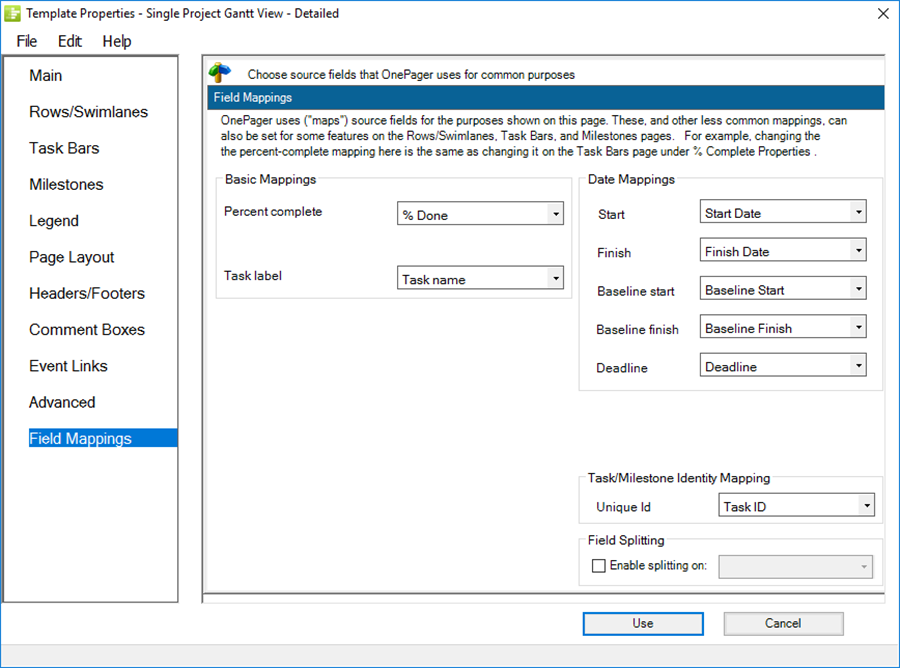
- i) The seven dropdown lists shown in the upper part of the form above are the common uses that our customers need most frequently, but there are other important purposes on the Rows/Swimlanes tab and the Task Bars and Milestones tabs of the PVP form.
- ii) The dropdown lists here contain field headings found on the active Microsoft Excel source plan when the Template form is accessed.
- iii) Each dropdown list has two components divided by a dotted line. The fields above the dotted line were properly classified as to data type when the project view was created. The list of fields below the dotted line are those remaining source plan fields that may have been inaccurately classied.
- iv) A typical dropdown list of source plan fields for the OnePager Express Field Mappings tab in the Template form might look like this:
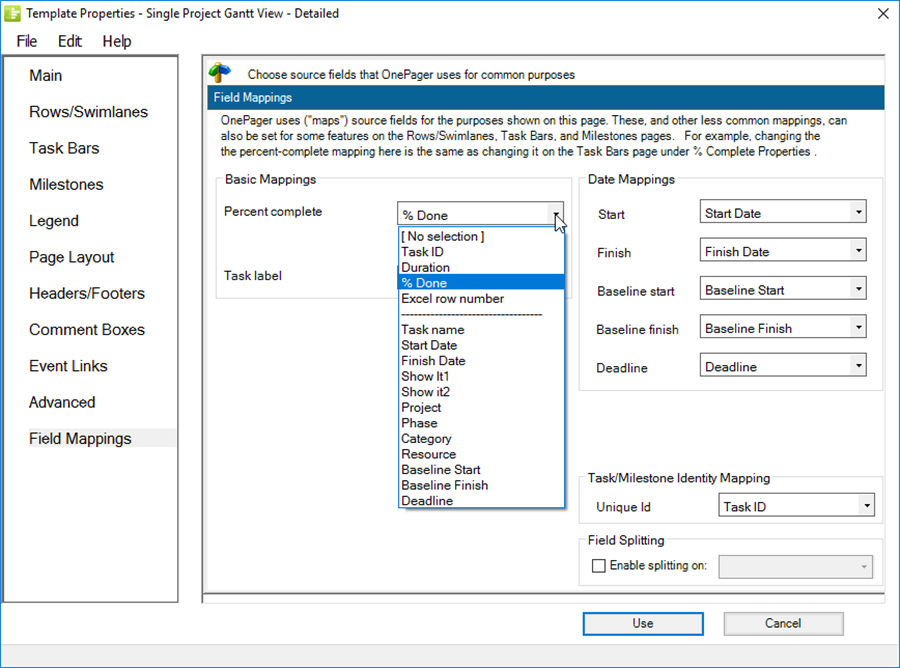
- f) The Field Splitting group in the Field Mappings tab of the OnePager Express Template form works in the same way as it did in the Other Columns tab of previous versions. See the article at: Splitting and Parsing Fields-MS Excel Source 24.5.1-OPL2 for more information.
- g) The Unique Id field in the Task/Milestone Identity Mapping group shows the Microsoft Excel source plan field that OnePager Express uses when it first created the project view and then retains for all future updates. The Task/Milestone Identity Mapping group is also found on the Project-View Properties form's Field Mappings tab, but it is disabled there because you cannot change the Unique Id after a project view is created.
3) As a note, please take a look at the paragraph just above the Field Mappings group title in the tab for both OnePager Pro and Express. Whenever you make a change to the Task Name, Percent Complete, and Critical fields in the Template form’s Field Mappings tab, OnePager will update the corresponding fields in the Gantt Bar Decorations group of the Task Bars and Milestone tabs.
Additional Tab for the Project-View Properties Form
1) The Project-View Properties (PVP) form in both OnePager Pro and Express did not have an Other Columns tab because it was not possible to change the field mappings for these purposes after a project view was created. The only place you could change these mappings was in the Template form before the project view was created.
2) With Unlimited Field Mapping you can change these important Field Mappings after project view creation in the PVP form.
3) The PVP form’s Field Mappings tabs for OnePager Pro and Express mirror the Field Mappings tabs in their respective Template forms.
4) As an example, suppose we change the PVP form’s Field Mappings tab’s Finish dropdown to use the source plan’s Start field as shown below:
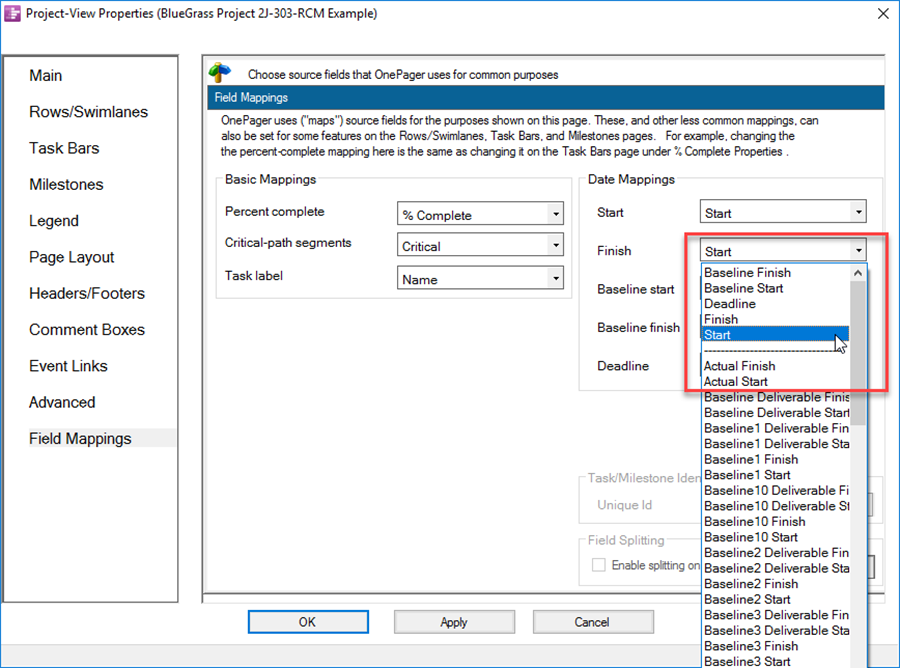
- a) If the project view looks like this before the above change is made:
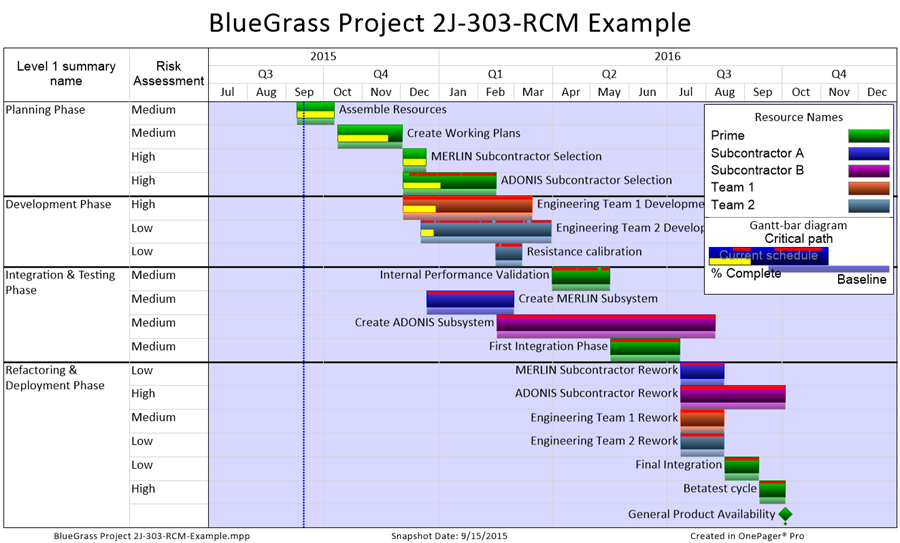
- b) After the Finish dropdown window is changed to show the Start field, the project view will look like this:
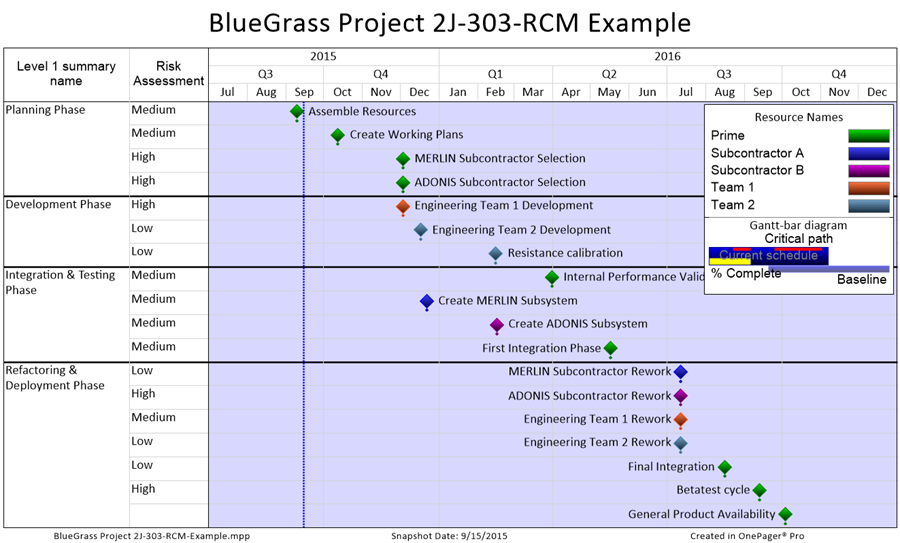
- c) Changing the usage of the Finish dropdown to read Start tells OnePager that the Start and Finish dates are the same and that the Task Bar should be represented as a Milestone symbol as shown above.
Related Links
Basic Workflows (Portal) 7.0.1-OPL2
Conditional Formatting (Portal) 11.0.1-OPL2
Using the OnePager "Data" Tab's "Selected file(s)" Button 7.17.1-OPL2
OnePager Live Import of Data from Microsoft Excel 4.0.1.4-OPL2
Understanding Project Views and Snapshots for OnePager Live 4.0.1.2-OPL2
Advanced Tab for OnePager Live-Reset Unique Ids On Update 21.13.1-OPL2
Splitting and Parsing Fields-MS Project Source 24.4.1-OPL2
Splitting and Parsing Fields-MS Excel Source 24.5.1-OPL2
(7.19.1-OPL2)